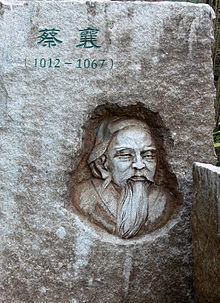Name Cai Xiang Role Engineer | Died 1067 | |
 | ||
Cai Xiang (Chinese: 蔡襄; pinyin: Cài Xiāng; Wade–Giles: Ts'ai Hsiang) (1012–1067) was a Chinese calligrapher, scholar, official, structural engineer, and poet. He had the reputation as the greatest calligrapher in the Song dynasty.
Contents
Biography
He was born during the Dazhongxiangfu (大中祥符) era of the Song dynasty in Xianyou (仙游) county of Xinghua (兴化) prefecture, now Xianyou County in Putian of Fujian province.
In the eight year of the Tiansheng (天聖) era (1030 CE) he obtained the degree of jinshi (進士, lit. "advanced scholar"), a graduate who passed the triennial court exam. His highest rank was Secretariat Drafter of the Duanming Court (Duanmingdian Xueshi), in charge of written communication of the imperial government. During the Qingli (慶曆) era (1041–1048 CE), he was the Officer of Transportation (Zhuanyunshi) in Fujian. While acting as a prefect in Fujian, he also was in charge of overseeing the construction of the Wan-an Bridge at Quanzhou.
He pioneered the manufacturing of small Dragon Tribute Tea Cake of superlative quality, as it was reputed to be harder to obtain than gold.
Cai Xiang's style name was Junmo (君谟), and his posthumous name was Zhonghuei.
Works
One of his most famous publications is his essay "The Record of Tea", also known as the "Tea Note", which he wrote in 1049–1053.
